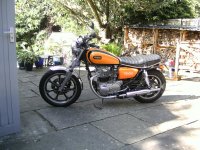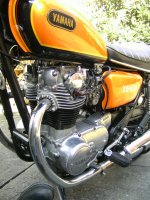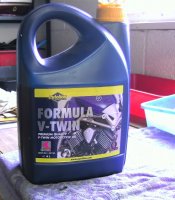Back yard this morning - note lack of rain.

Been making short jaunts trying work out what needs fixed first. We must have covered, oh, 7 or 8 miles by now?
The carburation might be off. But then again, it might be the spark timing.
On my first jaunt this morning, the bike ran well at very low revs & small throttle opening but would not take anything more, holding back, popping and banging. Yesterday, I felt sure the spark was retarded so today I loosened the magnets/rotor and advanced them 'by eye'.
Well, it feels better. But still needs to be checked and set by strobe. The bike continues to hold back as the throttle is opened. But if you persist - we're only talking a bit of throttle and maybe 3,000 revs - it catches and goes quite well. But, there's the clutch.
The newly greased and adjusted clutch is better but still feels very 'mushy' on take up. There's no 'biting point' - more of a wide region as the bike progressively gets under way and eventually the clutch is fully out. And the clutch slips under power. Tried adjusting - less gap at the handlebar end - but as the engine catches, the clutch abruptly slips and revs spike.
Only noticed one leak - oil on the fins just below the l/h spark plug. Must be coming from the points cover, though there's not a lot of oil inside the cover.
So still lots of fixing needed. But the good news is that on each of the four short trips we've made, the bike has felt better.
Been making short jaunts trying work out what needs fixed first. We must have covered, oh, 7 or 8 miles by now?
The carburation might be off. But then again, it might be the spark timing.
On my first jaunt this morning, the bike ran well at very low revs & small throttle opening but would not take anything more, holding back, popping and banging. Yesterday, I felt sure the spark was retarded so today I loosened the magnets/rotor and advanced them 'by eye'.
Well, it feels better. But still needs to be checked and set by strobe. The bike continues to hold back as the throttle is opened. But if you persist - we're only talking a bit of throttle and maybe 3,000 revs - it catches and goes quite well. But, there's the clutch.
The newly greased and adjusted clutch is better but still feels very 'mushy' on take up. There's no 'biting point' - more of a wide region as the bike progressively gets under way and eventually the clutch is fully out. And the clutch slips under power. Tried adjusting - less gap at the handlebar end - but as the engine catches, the clutch abruptly slips and revs spike.
Only noticed one leak - oil on the fins just below the l/h spark plug. Must be coming from the points cover, though there's not a lot of oil inside the cover.
So still lots of fixing needed. But the good news is that on each of the four short trips we've made, the bike has felt better.



